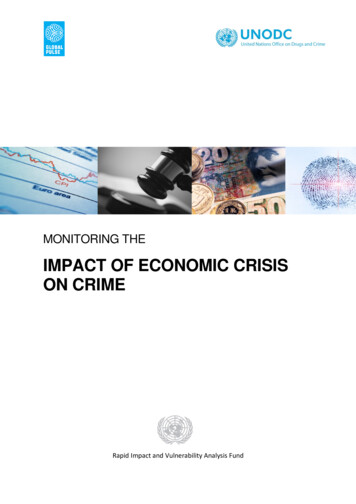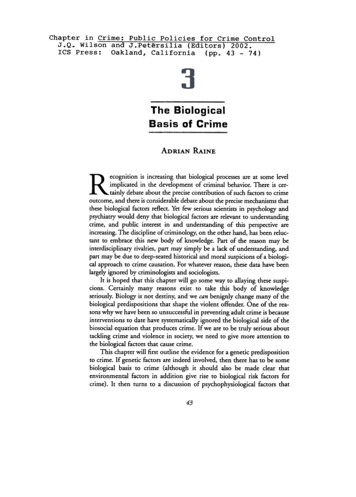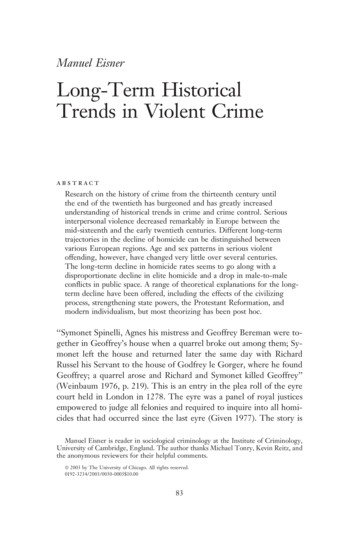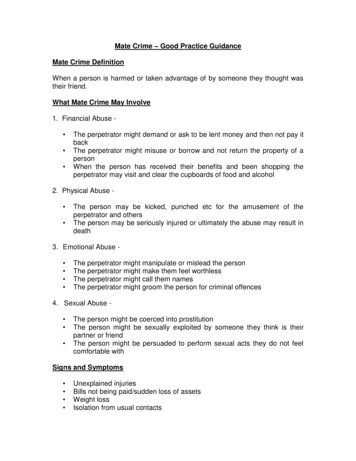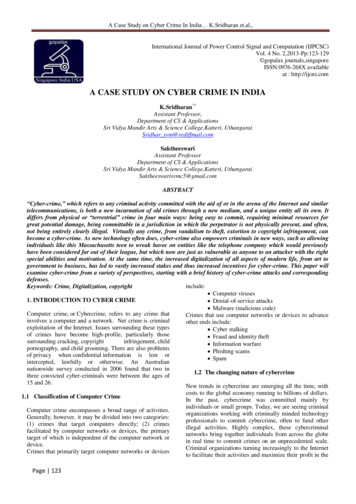
Transcription
COMPUTER CRIMEA JOINT REPORTState of New JerseyAttorney GeneralCommission of Investigationof New JerseyJUNE 2000
COMPUTER CRIMEA JOINT REPORTState of New JerseyCommission of InvestigationLESLIE Z. CELENTANOCHAIRAttorney Generalof New JerseyJOHN J. FARMER, JR.M. KAREN THOMPSONW. CARY EDWARDSAUDRIANN KERNANCOMMISSIONERSJUNE 2000The Report, complete with hypertext links, is available on theCommission’s Web site at www.state.nj.us/sci
COMPUTER CRIMETABLE OF CONTENTSINTRODUCTION1CHILDREN IN JEOPARDY44THE PROBLEMTHE MAKING OF PREDATORS: CYBERSPACE HELPSPEDOPHILES ACT OUT THEIR PERVERSIONNO EASY SOLUTIONSPARENTAL SUPERVISIONBLOCKING, FILTERING AND MONITORING SOFTWAREAND CHILD-FRIENDLY BROWSERSCHILD-FRIENDLY WEB SITESSCHOOL AND LIBRARY POLICIESCONTROL ORGANIZATIONS AND PROGRAMSUNESCOWhite HouseFederal Bureau of Investigation andOffice of the U.S. Attorney for theDistrict of New JerseyUnited States Customs ServiceFederal Trade CommissionNational Center for Missing andExploited ChildrenOffice of Juvenile Justice andDelinquency PreventionCyber Angels and Other HelpOrganizationsEnd Child Prostitution and Trafficking(ECPAT) and the World TourismOrganization (WTO)Internet Service ProvidersNew Jersey State PoliceLAWS AND LEGAL ACTIONSBIAS AND HATETHE PROBLEMCROSSING THE LINE FROM HATE SPEECHTO HATE CRIMECONTROL ORGANIZATIONS, PROGRAMS AND LAWSOFFICE OF BIAS CRIME AND COMMUNITY RELATIONSDIVISION ON CIVIL RIGHTSANTI-DEFAMATION LEAGUECENTER ON HATE AND 2364242434445
SOUTHERN POVERTY LAW CENTERNEW JERSEY COMMISSION ON HOLOCAUST EDUCATIONSIMON WIESENTHAL CENTERHATEWATCHOTHER ANTI-EXTREMIST ORGANIZATIONSHACKINGTHE PROBLEMPASSWORD TIPSWHEN CREATING A PASSWORD:ONCE YOU HAVE A PASSWORD:ENCRYPTIONCONTROL PROGRAMS AND METHODSINTERNET FRAUDCOMMON SCAMS SPREAD FAR AND FAST ONLINECOMMON FRAUDULENT SCHEMESCONTROL ORGANIZATIONS AND PROGRAMSFEDERAL TRADE COMMISSION (FTC)INTERNET FRAUD COMPLAINT CENTERINTERNET FRAUD COUNCILINTERNET FRAUD WATCHBBBONLINESECURITIES AND EXCHANGE COMMISSION (SEC)NORTH AMERICAN SECURITIESADMINISTRATORS ASSOCIATIONNATIONAL ASSOCIATION OF SECURITIESDEALERS (NASD)FEDERAL DEPOSIT INSURANCECORPORATION (FDIC)MAIL ABUSE PREVENTION SYSTEMNEW JERSEY DIVISION OF CONSUMER AFFAIRSIDENTITY THEFTAN ESPECIALLY EGREGIOUS FRAUDDEMONSTRATION OF ONLINE PITFALLSHOW TO AVOID BECOMING A VICTIMACTIONS VICTIMS MAY TAKERECENT LAWS AND CONTROL PROGRAMSNEW JERSEY LAW STRENGTHENEDFEDERAL LAW STRENGTHENED –ENHANCED ROLE FOR FTCOTHER CRIME-FIGHTING FEDERAL AGENCIESKEEPING PERSONAL INFORMATION PRIVATEAND ACCURATEPRIVATE HELP AND PREVENTION 080828383848484888894969899100100100101105
INTERNET GAMBLINGOFFSHORE FIRMS SERVE A GROWING DEMANDJUSTIFICATION FOR PROHIBITIONEFFECTIVENESS OF PROHIBITIONJUSTIFICATION FOR REGULATIONEFFECTIVENESS OF REGULATIONCOMPULSIVE CYBER-GAMBLING107107109110115118119E-COMMERCE IN ALCOHOLIC BEVERAGES AND TOBACCO121CHALLENGES FOR LAW ENFORCEMENT122122125127SPECIAL PROBLEMS OF COMPUTER-RELATED CRIMEJURISDICTIONSPECIALIZED COMPUTER CRIME UNITS WORKING TOGETHERCOMPUTER ANALYSIS AND TECHNOLOGYUNIT (CATU)HIGH TECHNOLOGY CRIME ANDINVESTIGATIONS SUPPORT UNIT (HTC&ISU)TRAININGRETENTION OF KEY PERSONNELRECOMMENDATIONS130130132134136STRENGTHEN NEW JERSEY’S COMPUTER ANDTECHNOLOGY CRIME LAWSINCREASE, TRAIN AND COORDINATE LAWENFORCEMENT RESOURCESINCREASE PREVENTION AND EDUCATIONACCESS TO ELECTRONIC RECORDS OF INTERNET USEONLINE PRIVACYRESTRAINING ONLINE SALESESTABLISH AND PUBLICIZE HOTLINES ANDCOMPLAINT PROCESSESMAINTAIN PROHIBITION ON INTERNET GAMBLINGiii136140142143144145145146
COMPUTER CRIMEINTRODUCTIONIn an unprecedented joint project, the State Commission ofInvestigation (hereinafter “Commission” or “SCI”) and then-AttorneyGeneral Peter G. Verniero held three days of public hearings oncomputer crime on February 23, 24 and 25, 1999. The hearings, withmore than 30 expert witnesses, capped extensive inquiries by theCommission and the Attorney General’s Office, headed since June 1999by Attorney General John J. Farmer, Jr. They underscored the need forlaw enforcement at all levels to coordinate efforts to control the“dark side” of the computer revolution. This includes prosecutinghigh-tech conduct offending criminal laws, pursuing civil remedies foronline wrongdoing, and helping adults and children to protectthemselves in cyberspace.Computer technology and communication confer obvious advantageson businesses, governments, schools and individuals. With nominalresources, people and institutions can, via computers, leap state andnational boundaries to explore vast stores of information and benefitfrom innumerable commercial opportunities. However, Commission ChairLeslie Z. Celentano cautioned in her public hearing opening remarksthat “[as] on any frontier, predatory elements seek to takeadvantage of those reaching for new opportunities.” With propersafeguards, adults and children should be able to enjoy and profitfrom cyberspace — sometimes called the “digital highway” or the“information superhighway” — without falling prey to schemers,predators and intruders.According to the U.S. Department of Commerce, 40 percent ofAmerican households owned personal computers at the end of 1998. Aquarter of those had access to the Internet, a global group ofinterconnected computer networks, communications equipment andsoftware. The Internet furnishes nearly 200 million worldwide usersaccess to measureless riches of information and services. According toForrester Research, Inc., which tracks Internet commerce, total U.S.business trade on the Internet reached 43 billion in 1998 and isprojected to rise to 1.4 trillion in 2004. Spending on Internetauction sites alone totaled 1.4 billion in 1998 and is predicted togrow to 19 billion by 2003.While each of the networks that make up the Internet is owned bya public or private organization, no single organization or governmentowns or controls the Internet. Originally created to further defense,scientific and academic endeavors, the Internet, which also affords
users the ability to communicate via electronic mail (“e-mail”), grewslowly but steadily until 1994. At that time, the World Wide Web (“theWeb”), the graphical user interface to the Internet, was introduced.The Web prompted extraordinary growth in both the size and theuse of the Internet. Once limited to military and educationalundertakings, the Web has expanded to become an integral and evenessential part of vast numbers of businesses and households. Itconsists of millions of electronic “storefronts,” or repositories,called Web sites. Businesses, organizations, government agencies andindividuals set up Web sites, which may be a combination of text,graphics, still pictures, videos and sounds. Each Web site has anInternet address called a uniform resource locator (URL).When it became clear that they could facilitate business-tobusiness and consumer-to-business electronic commerce (“e-commerce”),the Internet and the Web rocketed to importance in the economy. Onlinebusinesses now abound, and credit card purchases over the Internetoccur 24-hours-a-day.Befitting the vastness of cyberspace, which includes theInternet, computer-related crimes impacting New Jersey are varied andextensive. Child pornographers and pedophiles entice and exploitchildren via the Internet. Extremists and hate groups take advantageof high technology to rend society and foster bias-related crime.Unscrupulous individuals intrude upon supposedly secure computers anddatabases releasing catastrophic computer viruses and engaging inindustrial espionage. Swindlers in cyberspace undermine confidence ine-commerce. With the aid of fly-by-night Web sites, identity thievesglean personal information in order to enrich themselves at theexpense of their victims’ creditworthiness and reputations.Unregulated Internet gambling operations dupe the unwary. Lastly, hightechnology helps criminals foil law enforcement’s efforts to detectand prosecute a host of traditional crimes.Apart from the breadth of potential misconduct, the unique natureof the Internet presents challenges not evident in the traditional lawenforcement milieu. Enforcers must overcome problems involvingjurisdiction, evidence access and preservation, applicability ofcurrent laws, vulnerability of a virtually unlimited victim pool, andpractical obstacles to the identification of perpetrators.The Attorney General’s Internet Working Group was established in1997 and charged with coordinating the extensive high-technologyresources of the Department of Law and Public Safety in order toenhance the ability of the State’s law enforcement community toaddress Internet and advanced technology issues. The Internet WorkingGroup meets monthly to design strategies for handling computer-relatedpublic safety issues, including: child endangerment, threats andstalking, bias crimes, identity theft, online gaming, sale of drugs2
and other illegal products, Consumer Fraud Act violations anddiscriminatory practices. The Internet Working Group also advises theAttorney General on matters concerning Internet legislation andpolicy. Training is another important focus of the Internet WorkingGroup. Through the Department’s divisions, the Internet Working Groupensures that law enforcement agencies throughout the State are advisedof emerging high technology crimes and trained in methods toinvestigate and prosecute these crimes.The Internet Working Group is in the process of constructing aWeb site that will provide information to the public about safecomputing practices and the proper methods for reporting hightechnology crimes. The Web site will integrate information from avariety of sources, to provide a single resource where individuals andeducation, civic and business groups can keep abreast of developingcomputer crime issues.If an emergency or complex criminal matter requires it, theWorking Group can coordinate the State’s response. The ComputerAnalysis and Technology Unit (CATU) in the Division of CriminalJustice, the High Technology Crime and Investigations Support Unit(HTC&ISU) in the Division of State Police, prosecutors’ officepersonnel specializing in computer crime control, and the E-CommerceInvestigative Unit in the Division of Consumer Affairs are directlyinvolved in the effort. The Statewide Computer Crime Task Forceutilizes the combined assets of the HTC&ISU and the CATU. It includesrepresentatives of federal law enforcement as well as countyprosecutors’ offices and municipal police departments. The task forceis designing and implementing a training program for deputy attorneysgeneral and assistant prosecutors in the area of computers, computerforensics, the Internet and the legal issues associated with theinvestigation, presentation and admissibility of digital andelectronic evidence. The task force is proactive in disruptingcomputer crime activities within the New Jersey area by identifying,investigating, arresting and prosecuting individuals responsible forviolating the criminal statutes.Although we conclude this report with several recommendations tostrengthen society’s ability to fight computer-related crime, noamount of law enforcement can safeguard computer users better thantheir informed precautions. Therefore, the report comprehensivelydetails lessons learned during the joint project and refers readers tomany helpful institutions, programs and individuals. In this way, weexpect to assist citizens, as well as their public officials.This report contains a variety of links to Web sites andreferences to resources available through government, nonprofit andcommercial entities. Hypertext links are available in the copy of thereport found at the Commission’s Web site (www.state.nj.us/sci). Thelinks and references are provided solely for informational purposes.3
Their inclusion does not constitute endorsement. References totestimony in the report pertain to witnesses testifying at theFebruary 1999 public hearing.CHILDREN IN JEOPARDYTHE PROBLEMIt has been estimated that 11—15 million children in the UnitedStates are currently online. Industry experts estimate that the numberwill rise to 45 million by the year 2002. Through Urban Leaguecommunity centers, free public libraries, Newark’s Millennium Projectand like programs, poor children will achieve online experiencecomparable to those whose families can afford computers at home. Moreand more “latchkey kids” in empty houses or participants in afterschool programs will shun passive television and gravitate toward theInternet, where they can interact with other children and adults.Children use cyberspace to talk with friends, complete homeworkassignments, and explore museums, libraries and universities. Whileproviding almost limitless opportunities to learn, this “informationage” has exposed children to supercharged versions of the old threatsof child molestation and child pornography. Child molesters andpornographers take full advantage of Internet service providers(ISPs), Internet relay chat (IRC) (hundreds of thousands of electronic“chat rooms” where users can “talk” to others by typing on theirkeyboards), and the Usenet (tens of thousands of bulletin board-stylediscussion groups, often called “newsgroups”). These provide to suchpredators abundant hunting grounds in which to find young victims.Moreover, at nominal expense, and regardless of where they reside inthe world, they can, and do, readily view and trade or sell picturesand movies of young or very young children being sexually molested byadults, snuff erotica (real murder done for sexual arousal),bestiality and the like.IRC channels are similar to the chat rooms offered by ISPs, suchas America Online, but they are not proprietary and thus not subjectto any policing mechanisms ISPs often have in place. IRC channels areaccessible to anyone with an Internet connection and the necessaryfree software (“shareware”). The users of these channels cancommunicate in “real-time”; that is, they are able to type messagesthat are seen by others instantly. They may convey their messages toall of the other users on the channel, or they may communicateprivately one-to-one. They also may send and receive contraband files,such as videos or photographs.4
One significant difference between IRC channels and ISP chatrooms is that subscribers to the latter have unique and traceablescreen names assigned to them. IRC channel users can assume any screenname they want and change it at any time. This makes identifying andtracking IRC users more difficult, but not impossible.While newsgroups on the Usenet are great sources of informationon virtually any subject, they are, unfortunately, used by some as amedium for distributing child pornography and for advertising servicesinvolving the exploitation of children. Users’ messages are stored andmade available for many other people to read. A user may access andread all of the messages other people have posted. Contrary to commonmisconception, individuals who post illegal material to the Usenetdiscussion groups may indeed be traced, arrested and convicted. Peoplewho download child pornography from newsgroups may be traced, but notas easily as those who post such material. Some system administratorsoccasionally notice the downloading of files with unusual names andnotify law enforcement.Some ISPs merely give their customers access to the Internet.Others are also online service providers that make services, such as“chat” areas, available to their members only. These “rooms” arecreated by the ISP’s members themselves and cater to their privateinterests, which sometimes extend to child erotica. Although the termsof service (TOS) between ISPs and their customers often prohibitvulgar and sexually explicit room and screen names, such roomsflourish. Established ISPs, such as America Online, employ manytechniques to enforce their TOSs, including account termination foraccumulated violations. Currently, however, only a very smallpercentage of the child pornographers reported to ISP authorities havetheir accounts terminated. Even those who are terminated can switch toother ISPs. Their activities are not curtailed significantly untilthey are reported to capable, well-staffed law enforcement agenciesthat cooperate with one another across jurisdictional boundaries.Producers, purveyors and consumers of child pornography causegreat harm to children. As many as 70% of convicted child molestersalso collect child pornography. Since the advent of video technologyand digital photography, copious illicit images may be traded or soldinstantaneously. Moreover, digital images do not lose quality throughcopying. Thus, enormous quantities of high-grade child smut areavailable for rapid and widespread distribution.So-called “cyber-stalkers” or “travelers” are nothing more thanchild molesters seeking to have sex with the children they contactonline. Eugene J. (Gene) Weinschenk, former Director of the UnitedStates Customs Service’s CyberSmuggling Center, has reported that 75%of registered sex offenders routinely “surf” the Internet. Childrenexploited and victimized by cyber-stalkers often join the woeful ranksof the missing or abducted.5
Child sexual abusers are rapidly turning the Internet andcommercial online services into red-light districts, where they candistribute vast quantities of pornography — often depicting bondageand other forms of violence, including murder — and organize withlike-minded individuals. The Internet gives child molesters andpornographers unprecedented opportunities to target and recruit newvictims. It allows sexual predators to stalk juvenile victimsanonymously from the comfort of their homes.The Internet provides child molesters with a cloak of secrecy.Known solely by their computer code names, they pretend to be the sameage as their victims. Parents, who would hustle their children awayfrom such people at a playground, sometimes learn after it is too latethat they have been their children’s “bedroom buddies” via homecomputers. Predators can stalk children in their homes, schools andlibraries without having to appear physically at those places. In thisway, Internet-based child sexual exploitation can be a “silent” crime.Parents often first learn of such activity when a child tells ofmolestation or disappears.Mr. Weinschenk described a distressing scenario:The example that I always like to use is a little 10 or 11year-old boy will come in [to a chat room] and say, “My mom, shewon’t let me get a Sony Play Station.” The predator sits thereand makes these notes. He’ll wait awhile, try to figure out wherethe child is. The kids will say what school they go to, what town— eventually it will all come out.If I’m the predator, if I’m 54-year-old Gene, I’ll go back in as11-year-old Tommy and I’ll say, “You know what, my mom won’t letme buy it either.” And 11-year-old Tommy will say, “I have anUncle Gene, and he’s going to take me out Saturday to the malland buy me a Play Station because he thinks I should have one.He’ll buy one for you too. Why don’t you meet us at the mall.”They’re on their way.They show up at the mall in front of Toys-R-Us. “Hey, I’m Gene.Tommy is down in the store, you know, over in Macy’s somewhere.He said for me to buy this for you” and go in and buy him thePlay Station. They’ll go in the car . [Fifty-four] bucks orwhatever the Play Station [cost] and he’s got the child. Whetheror not the child is ever seen again, that’s another story.The anonymity of Internet communications can work to theadvantage of law enforcers as well as predators. A trafficker in childpornography, for example, could think he is talking to a child when hereally is talking to a detective. But sophisticated traffickerscounter such operations by screening out undercover detectives6
pretending to be pornography dealers. Such traffickers insist thattheir contacts forward child pornography before replying with theirown material. Since authorities will not release illicit images intocyberspace, sophisticated traffickers can fend off undercover stingoperations.Would-be molesters also bide their time to foil investigators.They may monitor a “kids-only” chat room, not saying anything thatwould get them into trouble. They then select certain children for a“buddy list,” which reveals when designated individuals are online.Later, when an intended victim goes online, the predator can send hera direct instant message that bypasses e-mail. Thus, even parentsoverseeing a child’s e-mail may not be aware of dangerouscommunication.National statistics on Internet sex crimes are scarce, butofficials believe such crimes are numerous and increasing. The JusticeDepartment cannot say how many crimes against children occur over theInternet because it does not break out those figures from overallstatistics. However, the number of all child pornography cases filedin federal court increased by 129% in 1996. William Megary, thenSpecial Agent in Charge of the FBI’s Newark Division, testified, “Ican say with certainty that the number of predators that are out thereclearly exceeds the ability of law enforcement to address them,without question.” The Crime Control Digest reported in August 1999that since January 1998 the U.S. Customs Service, the U.S. PostalInspection Service and the FBI had made over 460 arrests involving theexchange of child pornography on the Internet.Mr. Weinschenk testified that child pornography, traditionallyrestricted to bartering, is rapidly becoming a “very profitable”cottage industry. He cited a Customs Service arrest about two yearsago “where people were making 25,000 a day showing CD-ROMs of childpornography.” In May 1999, U.S. Customs Commissioner Raymond Kellyreported that 95% of child pornography that comes into the UnitedStates from abroad now arrives via the Internet.On September 1, 1998, in a stunning example of what can beachieved by worldwide law enforcement cooperation, authoritiescoordinated raids targeting 180 child-pornography traders in 14countries. The raids, assisted by the CyberSmuggling Center, resultedin more than 40 arrests. Four of the original 14 arrested in theUnited States committed suicide. The rest were prosecuted in federalcourt. Authorities had targeted "wOnderland," the largest, mostsophisticated online child pornography ring yet discovered. Theproject was called "Operation Cheshire Cat" in the United States and"Operation Cathedral" in the United Kingdom. The members of wOnderlandincluded a resident of West Orange, New Jersey. Three United Statesmembers were women. In order to be admitted to the club, a prospective7
member had to have at least 10,000 pornographic images of children onhis or her computer.WOnderland existed in Internet relay chat, where people cancommunicate and exchange files anonymously. For less than 100 permonth, wOnderland members could buy access to the club. They thencould go online, enter a private chat room and agree to exchangephotos. The photos were encrypted with codes from the former SovietKGB to prevent outsiders from gaining access to them. To join theclub, potential members needed current members to vouch for them.On October 28, 1998, 13 people and 2 Internet service providerswere arrested for involvement with a group called Pedo University.Participants on three continents called themselves "faculty members"and, in newsgroups, swapped images of children having sex. One ofthose arrested was a 67-year-old Bridgewater, New Jersey, man callinghimself "MRPERFECT" and using the computer screen name "lovable." Hewas arrested on state charges of endangering the welfare of a child.Mr. Megary related a recent case involving two offenders who werearrested after molesting a 12-year-old boy:When a federal search warrant was executed at the suspects’residence, investigators found four computer systems, one laptopcomputer, a network server, four printers, a CD-ROM recordingsystem, a digital camera and two video camcorders. More than1,700 computer diskettes and recordable CD-ROMs were alsorecovered, as well as a number of used computer hard drives,videocassettes, and numerous printed photographs. It wasdetermined that the subjects were videotaping their victims,converting the images to CD-ROMS, and distributing them on theInternet.A notorious New Jersey case illustrates the catastrophicconsequences that can flow from Internet child sexual exploitation.Last year, a teenager pled guilty to the September 27, 1997 slaying of11-year-old Eddie Werner, who had been selling candy door-to-door incentral New Jersey for a school fund-raiser. At the time of thekilling, the victim’s slayer was 15 years old. A 45-year-old LongIsland man pled guilty on July 22, 1999 to sexually molesting theyoung killer in New Jersey after meeting the then-14-year-old in anInternet chat room in 1996.State and local authorities continue to uncover instances ofadults using the Internet to set up sexual encounters with children.In January 2000, four New Jersey men were arrested for allegedlyarranging such meetings with 13-year-old boys and girls. The “victims”were part of a sting set up by law enforcement officials from Oceanand Monmouth counties, the State Police and the Wall and Dover8
Township police departments. The officials responded to a parent’scomplaint that an adult had propositioned her minor son online.The Internet also facilitates child sex tourism, which isarranged by certain miscreant travel agencies. The resultingseductions and assaults are recorded digitally, and images are sharedwith other sexual predators worldwide. Mr. Weinschenk testified,“There are whole groups that are dedicated to having sex with childrenor trading pictures or images of sex with children under three, underfive.” In recent years, some 25 countries, including the UnitedStates, France and Germany, have adopted laws allowing prosecution intheir home countries of people accused of having sex with minorsabroad.THE MAKING OF PREDATORS: CYBERSPACE HELPS PEDOPHILES ACT OUT THEIRPERVERSIONNot all persons with pedophilia are child molesters, but the oneswho are almost always collect child pornography. Many pedophiles arelaw-abiding citizens who have a sexual attraction towards children butcontrol their desires and lead normal lives. Others act on theirimpulses, with devastating consequences for the children theyencounter.Authorities must wait for pedophiles to act before they canisolate them from society. Experts report that the average childmolesting pedophile abuses 35 children before getting caught. Manycompulsively and systematically save collected child pornography tovalidate their actions, or as mementos and souvenirs. When sharingthese treasured keepsakes, they gain strong reinforcement from likeminded persons.The North American Man/Boy Love Association (NAMBLA), establishedin Boston in 1978, advocates abolishing the age of consent in sexualrelations. Its members contend that it is not wrong for adults to havesex with children. Indeed, NAMBLA members profess that when theycajole children into sex, they enrich the youngsters’ lives.Active pedophiles attempt to project a benign image to theirvictims. They try to separate children from adults who might protectthem. They ask the children to recruit others and advise them not totell their parents about any communication or rendezvous. They usepornography to lower children’s inhibitions and to blackmail them intokeeping silent about the abuse.The Internet allows child sexual predators to validate eachother’s degenerate behavior in pedophilia chat rooms and Web sites.Parry Aftab, Executive Director of Cyber Angels and a New Jerseylawyer, testified that her organization and Safeguarding Our Children9
— United Mothers (SOC-UM) documented 17,000 Web sites on the Internetdevoted to child pornography and pedophilia. By May 14, 1999, thenumber had jumped to 21,317, an increase of more than 4,300 sites —more than 25 percent in less than four months. The PedophileLiberation Front (PLF) encourages the creation of Web sites devoted tosex between adults and children, and it wants children to have accessto them. The National Center for Missing and Exploited Childrenestimates that there are about 10,000 Web sites maintained by computerpedophiles.However many such sites exist, they are like drops in the hugeocean that is the World Wide Web. In a July 1999 report, computerscientists at the NEC Research Institute in Princeton calculated thatthere were some 800 million pages on the Web as of February 1999, morethan double the 320 million pages they reported in December 1997.Computer pedophiles (typically white, middle or upper classmales, age 25 to 45) extol the virtues of sex with children andprovide neophytes with child pornography. This psychologicalvalidation leads budding child molesters to believe that they are notstrange or different after all and that it is society, with its lawsdeclaring sex with children and child pornography to be criminal, thatis wrong. They then continue the downward spiral into childexploitation, typically beginning by trading child pornography,progressing to sexually explicit online conversations with children,and eventually seeking child victims online for sex.Computer pedophiles share methods and means by which to reduce achild's inhibitions and facilitate seduction. Ms. Aftab testified:What they’re doing is teaching each other how to do it better sothat when a child says, “It’s okay to say no,” because that’swhat we’ve told our children, they say, “When a child says toyou, ‘It’s okay to say no,’ this is your response,” and theyscript out responses to get into the child’s trust. [Children]are not afraid of other children, not taught to be, so pedophilescome [online] pretending they’re another child until they earnthe trust of this child, and then they become a little bit olderand a little bit older, and they meet them before they exp
Justice, the High Technology Crime and Investigations Support Unit (HTC&ISU) in the Division of State Police, prosecutors' office personnel specializing in computer crime control, and the E-Commerce Investigative Unit in the Division of Consumer Affairs are directly involved in the effort. The Statewide Computer Crime Task Force



